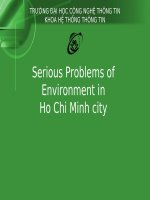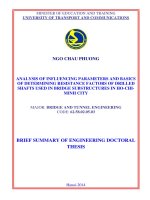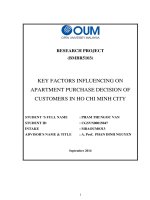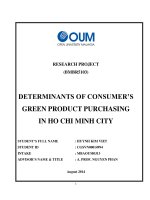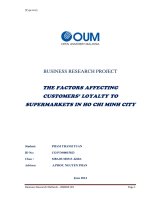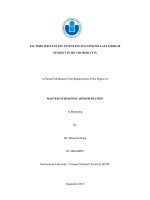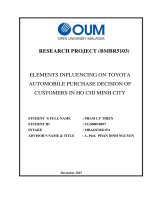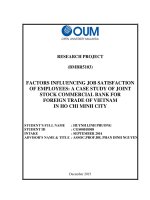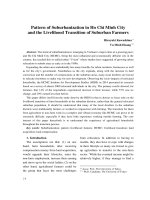Factors influencing consumers behavior of wine in ho chi minh city
Bạn đang xem bản rút gọn của tài liệu. Xem và tải ngay bản đầy đủ của tài liệu tại đây (1.86 MB, 72 trang )
TRƯỜNG ĐẠI HỌC MỞ TP.HCM
UNIVERSITÉ LIBRE DE BRUXELLES
HO CHI MINH CITY OPEN UNIVERSITY
SOLVAY BRUSSELS SCHOOL
MBMM4
Le Quang Vinh
Factors Influencing Consumers’ Behavior of Wine
In Ho Chi Minh City
MASTER PROJECT
MASTER IN BUSINESS & MARKETING MANAGEMENT
Tutor’s name: Dr. Ha Nam Khanh Giao
Ho Chi Minh City
(2010)
i
DECLARATION
I declare that this study does not incorporate without acknowledgment any material
previously submitted for a degree or diploma in any university; and that to the best of
knowledge it does not contain any materials previously published or written by another
person except where due reference is made in the text.
…………………………………………….
Signature of the Student.
Le Quang Vinh.
Master of Business and Marketing Management.
December 14th, 2010
Date.
ii
ACKNOWNLEDGEMENT
This study would not be possible without the advice, assistance, cooperation and
encouragement from a number of people. I would like to acknowledge their help and
support. The most important individual have been my supervisor, Professor Dr. Ha Nam
Khanh Giao. I am most indebted to Professor Dr. Khanh Giao, who showed an interest and
attention in my study. His advice and generous guidance since the first term that I begun
this study have been very supportive and lead me to the right track of study, and made this
research possible.
Moreover, I would like to express my appreciation to Professor Dr. Nguyen Minh Kieu,
who provided me the initial guidance of research method. I also would like to thank
Professor Dr. Hoang Trong, who provided me valuable knowledge of business statistics
and SPSS. Dr Trong also gave me very precious comments on data processing methods
and how to explain the SPSS results. Solathien company and my mentor, Mr. Nguyen Phu
Hai also have my deep gratitude for providing me the market report materials and value
discussions on the consumers’ choice of wine.
Besides, I would like to thank Mr. Serge Bywalski and Ms. Nguyen Thi Mong Thuy,
Coordinators of the MBMM Program for their devoted supports. Mr. Phan Le Dung,
Solvay Vietnam Alumni also has my deep gratitude for valuable advices. Moreover, I
would like to thank Solvay Business School Vietnam and Ho Chi Minh City Open
University for delivering the wonderful MBMM program.
Last, but not least, I wish to thank my family members for their love, assistance,
encouragement and patience.
iii
TUTOR’S COMMENTS
The study is a highly practical research. The research objectives were defined
correctly. The structure of the study is rational.
The author used the proper research method. The findings are quite interesting with
suitable scientific approach. In the result, the author pointed out that the symbolic
benefits are the most important factor influencing the consumers’ behavior of wine
in Ho Chi Minh City. Besides, the country of origin and grape varieties, which are
being used as wine value proposition, were proved to be not significant. Based on
this finding, the author also proposed some useful suggestions for marketers of
wine in the market.
However, the study has some limitations, such as the survey area and sampling
method; or the generalised target population …
In summary, the quality of the study meets the requirements (both content and
presentation) of a Marketing master thesis.
I propose this study to be presented in front of the examiner board of the Solvay – OU
Master of Business and Marketing Management Program.
Ho Chi Minh City, December 14th, 2010
Dr. Ha Nam Khanh Giao
iv
CONTENT
DECLARATION .................................................................................................................... i
ACKNOWNLEDGEMENT .................................................................................................. ii
TUTOR’S COMMENTS ......................................................................................................iii
CONTENT ............................................................................................................................ iv
LIST OF FIGURES .............................................................................................................. vi
LIST OF TABLES ............................................................................................................... vii
1. EXECUTIVE SUMMARY ........................................................................................... 1
2. INTRODUCTION......................................................................................................... 2
2.1. Chapter Overview ................................................................................................... 2
2.2. Rationale of the Project ........................................................................................... 2
2.3. Vietnam Wine Market ............................................................................................. 2
2.4. Aim of the Research ................................................................................................ 6
2.5. Research Outline ..................................................................................................... 8
3. LITERATURE REVIEW.............................................................................................. 9
3.1. Chapter Overview ................................................................................................... 9
3.2. Consumer Behavior Models .................................................................................... 9
3.3. The Motivation to Drink Wine .............................................................................. 15
3.4. Vietnamese Consumer Lifestyle ........................................................................... 19
3.4.1. Vietnamese favor foreign brands ................................................................... 19
3.4.2. Spending on alcoholic drink .......................................................................... 19
3.4.3. Vietnamese drinking habits ........................................................................... 20
3.5. Chapter Summary.................................................................................................. 20
4. RESEARCH DESIGN ................................................................................................ 21
4.1. Chapter Overview ................................................................................................. 21
4.2. Conceptual framework .......................................................................................... 21
4.3. Hypotheses Development...................................................................................... 22
4.4. Concept Operationalization ................................................................................... 22
4.5. Survey Design ....................................................................................................... 25
4.5.1. Questionnaire design...................................................................................... 25
4.5.2. Sampling method ........................................................................................... 25
4.5.3. Sample size .................................................................................................... 25
4.6. Chapter Summary.................................................................................................. 26
5. DATA ANALYSIS & FINDINDS ............................................................................. 27
5.1. Chapter Overview ................................................................................................. 27
5.2. General Descriptive Information........................................................................... 27
5.2.1. Research response rate ................................................................................... 27
5.2.2. Gender, Age and Income ............................................................................... 27
5.2.3. Favorite communication channels and wine consuming place ...................... 29
5.3. Factors Influencing of Wine Consumption ........................................................... 31
v
5.3.1. EFA for all the valid scales ............................................................................ 33
5.3.2. Multiple regression analysis .......................................................................... 35
5.3.3. Discriminant analysis for conceptual framework 1 and hypotheses testing .. 38
5.3.4. Discriminant analysis for conceptual framework 2 and hypotheses testing .. 41
5.3.5. Evaluation of the relationship between the factors and Average bottle
consumed per month ................................................................................................... 42
5.3.6. Evaluation of the relationship between Communication channel and
Consuming place with Average bottle consumed per month...................................... 46
5.3.7. Classification of the responses of open question ........................................... 47
5.4. Findings ................................................................................................................. 48
5.5. Chapter Summary.................................................................................................. 49
6. RESEARCH CONCLUSIONS ................................................................................... 50
6.1. Chapter Overview ................................................................................................. 50
6.2. Research Summary................................................................................................ 50
6.3. Research Limitations & Future Research Suggestions ......................................... 51
6.4. Managerial Implications........................................................................................ 52
6.5. Chapter Summary.................................................................................................. 54
REFERENCES .................................................................................................................... 55
APPENDICES ..................................................................................................................... 57
Appendix 1: Survey questionnaire .................................................................................. 57
Appendix 2: SPSS results ................................................................................................ 64
vi
LIST OF FIGURES
Figure 2.1: Sales of Wine by Subsectors - Total Volume 2004 - 2009 ................................. 5
Figure 2.2: Sales of Wine by Subsectors - Total Value 2004 - 2009 .................................... 5
Figure 2.3: Research process ................................................................................................. 7
Figure 3.1: A.H. Maslow’s hierarchy of needs .................................................................... 10
Figure 3.2: Howarth Sheth Model ....................................................................................... 11
Figure 3.3: Engel-Blackwell-Kollat Model ......................................................................... 12
Figure 3.4: Nicosia Model ................................................................................................... 13
Figure 3.5: Input, Process, Output Model ............................................................................ 14
Figure 3.6: A purposive analysis of wine consumption....................................................... 17
Figure 3.7: Why do people drink wines? ............................................................................. 18
Figure 4.1: Conceptual framework ...................................................................................... 21
Figure 4.2: Detail conceptual framework ............................................................................ 24
Figure 5.1: Gender of respondents ....................................................................................... 28
Figure 5.2: Age groups of respondents ................................................................................ 28
Figure 5.3: Average monthly income of respondents .......................................................... 29
Figure 5.4: Marketing efforts - Communication channel .................................................... 30
Figure 5.5: Marketing efforts - Wine consuming place ....................................................... 31
Figure 5.6: Adjusted conceptual framework after EFA ....................................................... 35
Figure 5.7: Adjust conceptual framework 1 ........................................................................ 37
Figure 5.8: Adjusted conceptual framework 2 ..................................................................... 37
Figure 5.9: Themes from open question .............................................................................. 47
vii
LIST OF TABLES
Table 4.1: Concept operationalization and measurement scales ......................................... 24
Table 5.1: EFA & Cronbach's Alpha for each concept / dimension .................................... 32
Table 5.2: EFA result - Full scales ...................................................................................... 34
Table 5.3: Multiple Regression result .................................................................................. 36
Table 5.4: Discriminant analysis result - Average bottle consumed per month .................. 40
Table 5.5: Discriminant analysis result - Average price per bottle ..................................... 42
Table 5.6: ANOVA result - Symbolic benefit factor ........................................................... 44
Table 5.7: ANOVA result - Enjoyment benefit factor......................................................... 45
Table 5.8: ANOVA result - Utilitarian & Experiential benefit factor ................................. 46
Table 5.9: Chi-Square result - Communication channel & Wine consuming place ............ 47
1
1. EXECUTIVE SUMMARY
Vietnam wine market is growing fast. More and more wine producers, importers and
distributors enter the market and compete against each other to bring their products to the
consumers. Most of them focus on the product features (country of origin, grape varieties,
taste, bottle and label). This study was conducted to find out if there are other factors
affecting the consumers’ choice of wine in Ho Chi Minh City.
Firstly, a conceptual framework was built based on the Input, Process, Output consumer
behavior model, a qualitative research about perceptions of wine quality (Charters, 2003)
and Vietnamese drinking habits (Euromonitor, 2010). From the conceptual framework,
four hypotheses about the relationships of Marketing efforts, Utilitarian benefits,
Experiential benefits and Symbolic benefits with the Money spent on wine were
developed. The questionnaire was built and 386 valid cases were filtered out of 450
responses. The valid responses were input to SPSS for further analysis.
Secondly, EFA was employed to remove unsuitable variables and extract the factors from
the measurement scale. The result was a bit different from the original conceptual
framework. The Symbolic benefit and Marketing effort factor was the same, but there were
two new factors, Utilitarian & Experiential benefit and Enjoyment benefit factor. The
multiple regression model was not statistically significant for finding the relationship
between the factors and the Money spent on wine. So discriminant analysis method was
used to evaluating the contribution of factors to the differentiation between consumers’
group presented by average bottle consumed per month. Other analyses also were done to
evaluate the relationship of communication channel and drinking place with consumers’
group. The findings from these analyses were used to provide suggestions for wine
marketers in Ho Chi Minh City market.
Finally, the Symbolic benefit factor turned out to be the strongest contribution to the
differentiation of consumers’ group. The importance of this factor also had a tendency to
increase when people consume more wine. This is an interesting guideline for wine
marketer to produce communication messages that differentiate their wines. For example,
marketers can focus on symbolic values linking with wine, such as self-image, lifestyle or
the importance of ritual instead of talking about the country of origin or grape varieties,
which is being used by everyone. To a lesser extent, the Enjoyment and Utilitarian &
Experiential factors contributed to the discrimination of consumer group as well. However,
the relationships of these two factors and the average bottle consumed per month were not
statistically proven.
2
2. INTRODUCTION
2.1. Chapter Overview
This chapter provides the project overview. It begins with the reason of this project,
followed by the general background information relating to the Vietnam wine market. The
key concepts of the research are also presented and, finally, this chapter concludes with the
outline of this study.
2.2. Rationale of the Project
Vin Attitude is a young and modern French wine producer in Côte du Rhone region,
France (www.vin-attitude.com). It represents 2,150 ha vineyard, 550 growers, more than
100,000 hl annually and a turnover exceeding 12 million €. The company is looking for a
long – term partnership who understands the local market and has a systematically
approach. Unlike other wine producers and brokers have been penetrating Vietnam market,
Vin Attitude is more willing to take risk for better controlling of marketing activities by
choosing a foreign based agent instead of an importer / distributor.
Solathien is a Vietnamese importer and distributor specialized in premium imported
Vodka. In order to exploit the existing distribution network and enrich the product
portfolio, Solathien seeks out a French wine producer who wants to enter Vietnam market.
After contacting with many companies, Solathien comes to agreement with Vin Attitude to
act as a foreign based agent in Vietnam market.
Both companies are the newcomers to a potential but also competitive market. In order to
have proper marketing strategy, the companies should have good understanding about the
consumer behavior of wine, especially in the key markets, e.g. Ho Chi Minh City and
Hanoi.
Because of the need of the companies, the project is implemented to study the consumer
selection of wine in Ho Chi Minh City. Based on the findings, recommendations will be
used form the marketing strategy of the company. The findings are also served as reference
for wine producers and importers who want to penetrate Vietnam market.
2.3. Vietnam Wine Market
In general consumption of wine in Vietnam, as well as in other Asian countries such as
China or Hong Kong, is rising. Over the past two years demand for wine in Vietnam was
high for many reasons. Despite the price of a bottle of wine being higher than that of a
carton of beer, some more affluent consumers changed their preferences and increased
consumption of wine, believing it to be good for their health. Second, living standards have
3
improved, and high income Vietnamese like to spend a large proportion of their money in
restaurants and hotels. Consequently a lot of companies aim to serve wine to these
consumers, as they represent a stable consumption base. Thirdly, many people follow
western lifestyles, and believe that wine illustrates their knowledge of modern lifestyles as
the country increasingly integrates with the rest of the world.
There are two types of wine regarding the quality in the wine environment in Vietnam.
Low quality wine is sold widely through street shops and supermarkets. High quality wine
is mainly distributed through restaurants, hotels and sold at high prices to consumers with
good knowledge of wine.
There are varieties of price for wine in Vietnam. The key price for wine is around VND
100,000. If old world wine has an average liter price of under VND 100,000, there is a
general belief that this product is not good quality. However, consumers believe they get a
better taste from new world wine if it costs at least VND 100,000. The price segmentation
here is mostly driven by producers and distributors. Imported wine is still a luxury product
for the average consumer, but there are various products available at different prices.
The most popular countries for wine are France and Chile, followed by Italy, Spain,
Germany, Australia, New Zealand, South Africa, America, Chile and Argentina. France is
considered the best choice for Vietnamese consumers, who hold French wine in very high
regard. This is the traditional perception, which is difficult to change. However, Chilean
wine is becoming increasingly popular.
Glass bottle is the dominant packaging format for wine, accounting for 95% of sales in
imported wine and local industrial wine. This is the traditional packaging format, as it
protects the quality and flavor of the wine. Wine in glass bottles is sold in both on- and offtrade channels in Vietnam. Local wine can be stored in ceramic packaging, or in PET
bottles for home-made wine.
Vietnamese consumers prefer foreign wine. In the north of the country wine from Chile is
favored and is developing strongly. Wine from France has an advantage as it has been
available for a long time in Vietnam and is considered good quality. For domestic wine,
Dalat Red Wine leads, benefiting from the wide distribution. Dalat wine is different from
Hanoi wine and considered a superior offer for urban consumers. Hanoi wine and Thang
Long wine are consumed in the north. Thang Long wine accounts for around 40% of
demand in the northern region.
Regarding local products, Dalat wine is highly popular among consumers and saw a good
sales performance in 2008. Growth increases steadily and its products are present
4
throughout the country and exported to Asian countries such as Japan, Korea, Malaysia
and Cambodia.
Local producers account for around 50 million liters of alcohol and sales are three times
greater than international producers’ in terms of volume. Local wine also competes
strongly with international wine thanks to its considerably lower price, as it is not subject
to import tax. However, Vietnam offers potential demand for wine, especially VIN wine,
but local VIN wine producers have to improve their product quality, service, and brand
image. In the near future local producers face tough competition with the large
international manufacturers and brands when import tax is decreased as a result of WTO
integration.
Regarding imported wine, there are hundreds of new brands launched every year in the
wine environment in Vietnam. Wine from New Zealand entered Hanoi in 2008. Wines
such as Merlot, Chardonnay, Pinot Noir and Sauvignon Blanc from New Zealand are
highly praised, and other famous varietals such as Riesling, Cabernet Sauvignon, Pinot,
Cabernet Franc, Malbec, Syrah, Chemin Blac and Gewürztraminer are also present in the
country. New Zealand wine is welcomed by Vietnamese consumers due to its prestige
image and good taste even though it is new. It is estimated that New Zealand wine will
take share from wines of other origin from 2009 onwards.
Local producers like LamDong Foodstuffs JSC (Ladofoods) are more active to provide
new products to consumer. The company always tries to launch the new products or
variants during the event of Dalat city, for example, Dalat Wine Festival, Dalat Flower
Festival. Dalat is one of the main tourist attraction places not only for foreigners but also
Vietnamese therefore it is a good chance for company to promote their own brands and
also company awareness.
New world wine is gaining popularity. The reason is that old world wine is made purely
from grapes without adding sugar, but new world wine normally has added sugar and the
taste is consequently sweeter. Vietnamese prefer sweet, especially women and consumers
in the south. Consequently both new and old world wines benefit from a loyal consumer
base. Prices are competitive and consumers can find both cheap and expensive products in
both categories. For example, French Champagne prices range from VND60, 000 to VND6
million. Competition between new and old world wine is in terms of brand and taste rather
than price.
5
Figure 2.1: Sales of Wine by Subsectors - Total Volume 2004 - 2009
Source: Euromonitor, March 2010
Figure 2.2: Sales of Wine by Subsectors - Total Value 2004 - 2009
Source: Euromonitor, March 2010
6
2.4. Aim of the Research
The Vietnamese consumers are facing many types of wine from local non-grape wine to
imported wine with very high price. These wines also vary in region of origin, packaging
and quality. Moreover, wine is quite a complicated product, and the perception of wine
quality of the consumer is much diversified.
So far the wine producers, importers and distributors don’t invest much in the marketing
and communication activities. Although wine is not banned from advertising, the
consumers rarely see the communication of wine in the TVC or press. The information
about the products is mostly presented on the website of the importers or distributors.
Though there are many wine fairs in Vietnam every year, the main target audiences of
these events are importers and distributors, not the end consumers.
So, there is neither much information nor research about how the Vietnamese consumers
select their wines. Therefore, this study will explore and evaluate a proper model for wine
consumption of Vietnamese people. Due to the limitation of time and resources, this
project will mainly focus on Ho Chi Minh City market, one of the largest markets of wine
in Vietnam. The findings drawing from this market can be applied for other regions in
South Vietnam.
There are two main objectives in this research:
Define and measure the factors influencing the consumer behaviors of wine in Ho
Chi Minh City.
Provide recommendations for host companies and other wine producers and
importers who want to penetrate the Vietnam market.
As per mentioned above, the research will explore and measure the factors influencing
consumer’s wine selection. There are two main stages of the research:
Secondary research: study the consumer behavior theory and model; Vietnam
consumer demographic and lifestyles; wine marketing concepts and consuming
behavior to define the factors influencing the consumer behaviors.
Primary research: conduct quantitative research to measure the relationship
between these factors and study the findings to infer the recommendations.
The research process can be described as following:
7
Preliminary
information
gathering &
literature survey
Theoretical
framework
development
Research
hypotheses
Research design
Quantitative data
collection
Data analysis
Interpretation of
findings
Recommendations
Figure 2.3: Research process
Source: Developed for this project
8
2.5. Research Outline
Chapter Three of this study further lists and illustrates the previous research and literature
related to this study. Also, some relevant theories, key concepts and components of this
research and the development of the research problem will be addressed in this chapter.
After the literature review, Chapter Four will describe the research methods including the
research models, research design and research methods. Chapter Five outlines the results
and findings of this research. Finally, Chapter Six draws conclusions and summarizes the
findings of this research and provides recommendations for target audience and future
researches.
9
3. LITERATURE REVIEW
3.1. Chapter Overview
The previous chapter has briefly discussed the general research background, the overview
of Vietnam wine market and the key research objectives. This chapter provides the
previous theories and research concerning the key concept. First, it begins with reviewing
different consumer behavior models and the process of consumer decision making. The
literature about wine drinking motivation is also presented. Finally, it ends with the
Vietnamese consumer lifestyle issues relating to alcoholic drinks and wines consumption.
3.2. Consumer Behavior Models
Consumer behavior includes all of the activities of buyers, ex-buyers and potential buyers
from pre-purchase deliberation to post-purchase evaluation, and from continued
consumption to discontinuance. It extends from the awareness of a want, through the
search for and evaluation of possible means of satisfying it, and the act of purchase itself,
to the evaluation of the purchased item in use, which directly impacts upon the probability
of repurchase (Alba et al., 1991).
Consumer behavior is most frequently modeled as a cognitive process, an intellectual
sequence of thinking, evaluating, and deciding. These information processing activities are
believed to shape the more overt aspects of choice: acquiring information, perhaps from an
advertisement or salesperson, placing an order, using the product selected, and so on. The
inputs to the process are the most basic bits of data available to the consumer, stimuli from
the environment in the form of marketing messages and conversations with friends and
relatives. The processing itself consists in the mental treatment of these data as the
consumer stores them, links them with existing ideas and memories, and evaluates their
relevance to his or her personal goals. The outputs are the attitudes the consumer forms
toward say an advertised brand, an intention to buy or postpone buying, and – if attitude
and intention are positive – the act of purchase. A similar sequence characterizes the use of
the purchased item: it is evaluated again in use and a decision is reached about its
suitability for repurchase.
There are various consumers’ models which help in the understanding of consumer
behavior. Some of them are listed below:
Economic Model
Psychological Model – A.H. Maslow
Pavlovian Model
Input, Process, Output Model—Gandhi: Philip Kotler
Sociological Model
10
Howarth Sheth Model
Engel-Blackwell-Kollat Model
Nicosia Model
The Economic Model, Psychological Model and Sociological Model are quite simple. The
Economic Model assumes that consumers follow the principle of maximum utility based
on the law of diminishing marginal utility. The consumer wants to spend the minimum
amount for maximizing his gains.
On the other hand, The Psychological Model explains the causes which lead to purchases
and decision-making. This has been answered by A.H. Maslow in his hierarchy of needs.
The behavior of an individual at a particular time is determined by his strongest need at
that time. This also shows that needs have a priority. Firstly they satisfy the basic needs
and then go on for secondary needs.
The Sociological Model is concerned with the society. A consumer is a part of the society
and he may be a member of many groups in a society. His buying behavior is influenced
by these groups. Primary groups of family friends and close associates exert a lot of
influence on his buying.
Figure 3.1: A.H. Maslow’s hierarchy of needs
Sources: A.H. Maslow, 1970 (Motivation & Personality)
The Pavlovian Learning model, Howarth Sheth Model, Engel-Blackwell-Kollat Model,
Nicosia Model are more complicated. The Pavlovian Learning Model suggests that human
behaviors are based on some central concepts: the drives, stimuli, cues, responses and
reinforcements which determines human needs and need satisfying behavior. Individually,
a drive is a strong internal stimulus which compels action. Stimuli are inputs which are
capable of arousing drives or motives. Cues are signs or signals which act as a stimulus to
a particular drive. The way an individual reacts to the stimuli is known as his response. If
the response to a given stimulus is rewarding, it reinforces the possibility of similar
response when faced with the same stimulus or cue.
11
The Howarth Sheth Model is slightly complicated and shows that consumer behavior is
complex process and concepts of learning, perception and attitudes influence consumer
behavior. This model of decision-making is applicable to individuals (Figure 5: Howarth
Sheth Model).
Figure 3.2: Howarth Sheth Model
Source: C.N. Krishna Naik, L. Venugopal Reddy, 1999 (Consumer Behavior – Discovery
Publishing House)
The Engel-Blackwell-Kollat Model consists of four components: Information processing,
Central control unit, Decision process, Environmental influences (Figure 6: EngelBlackwell-Kollat Model).
12
Figure 3.3: Engel-Blackwell-Kollat Model
Source: C.N. Krishna Naik, L. Venugopal Reddy, 1999 (Consumer Behavior – Discovery
Publishing House)
The Nicosia Model explains the consumer behavior on the basis of four fields shown in the
diagram (Figure 7: Nicosia Model).
13
Figure 3.4: Nicosia Model
Source: C.N. Krishna Naik, L. Venugopal Reddy, 1999 (Consumer Behavior – Discovery
Publishing House)
Input, Process, Output Model describes the consumer decision making process as three
distinct but interlocking stages: the input stage, the process stage and the output stage.
These stages are depicted in the simplified model of consumer behavior in Figure 8.
14
Figure 3.5: Input, Process, Output Model
Source: L.G. Schiffman, L.L. Kanuk, 2004 (Consumer Behavior – Prentice Hall)
15
The input stage influences the consumer’s recognition of a product need and consists of
two major sources of information: the firm’s marketing efforts (the product itself, its price,
where it is sold and its promotion) and the external socio-logical influences on the
consumer (family, friends, neighbors, other informal and noncommercial sources, social
class, and cultural and sub-cultural memberships). The cumulative impact of each firm’s
marketing efforts, the influence of family, friends, and neighbors, and society’s existing
code of behavior, are all inputs that are likely to affect what consumers purchase and how
they use what they buy.
The process stage of the model focuses on how consumers make decisions. The
psychological factors inherent in each individual (motivation, perception, learning,
personality, and attitudes) affect how the external inputs from the input stage influence the
consumer’s recognition of a need, pre-purchase search for information, and evaluation of
alternatives. The experience gained through evaluation of alternatives, in turn, affects the
consumer’s existing psychological attributes.
The output stage of the consumer decision-making model consists of two closely related
post-decision activities: purchase behavior and post-purchase evaluation. Purchase
behavior for a low-cost, nondurable product (e.g., a new shampoo) may be influenced by a
manufacturer’s coupon and may actually be a trial purchase; if the consumer is satisfied, he
or she may repeat the purchase. The trial is the exploratory phase of purchase behavior in
which the consumer evaluates the product through direct use. A repeat purchase usually
signifies product adoption. For a relatively durable product such as laptop (“relatively”
durable because of the rapid rate of obsolescence), the purchase is more likely to signify
adoption.
Taking into account of the fact that there is no research on this field so far, the Input,
Process, Output model is selected for this study. This model is comprehensive enough but
is not too complicated. The elements of this model will be considered with the following
aspects: the motivation to drink wine and Vietnamese consumer lifestyle to form the
conceptual framework of the study.
3.3. The Motivation to Drink Wine
The exploration of consumer motivation then uses a consumer-focused research project to
explore wine drinkers’ own views on why they drink and a range of symbolic and
experiential factors will be explored, including historical tradition, situation (including the
importance of food), cultural factors, self-image, enjoyment and relaxation.
The discipline of consumer behavior developed with a focus on the utilitarian dimension of
consumption – that is, the distinct physical and functional benefits provided by a product.
Its methods tended to concentrate on consumers’ cognitive processes, particularly
16
information gathering and processing as determinants of consumption behavior. This
includes, for instance, the stream of work based on Fishbein and Ajzen’s theory of
reasoned action (Ajzen & Fishbein, 1980; Fishbein & Ajzen, 1975), subsequently applied
to wine by Thompson and his colleagues (Thompson & Vourvachis, 1995; Thompson et
al., 1994). In this interpretation the consumer is seen to be very much a cognitive analyst of
precise functional benefit, weighing up the pros and cons of various product alternatives
before buying the most cost-effective in the circumstances.
Two challenges to this unidimensional approach developed. The first, stemming from a
psychological perspective, came from the work of Dichter (1964), later developed by Levy
(1981; 1986) and then others. This approach focused on the symbolic meaning of
consumer goods and thus how we use products to convey messages about ourselves.
‘Symbolic consumption’ as a paradigm has produced substantial bodies of research into,
and explication of, consumption behavior. It has been suggested by Richins (1994) that the
symbolic use of consumption can be split by separating representations of interpersonal
ties (an outward directed focus) from identity and self-expression (an inner-directed focus).
In the early 1980s a second paradigm developed which contrasted utilitarian with
experiential and hedonic consumption (Hirschman & Holbrook, 1982; Holbrook &
Hirschman, 1982). This interpretation was developed in a series of research papers to show
that experiential processes (fun, amusement, sensory stimulation, excitement and
enjoyment) were closely linked to the consumer’s engagement with the product. It was also
suggested that sensory cues are likely to be non-verbal and affective rather than reducible
to words – a factor which is particularly relevant to wine consumption, where sensation
rather than language may frame the drinker’s engagement with the product (Solomon,
1990).
This triadic approach to consumption (utilitarian, symbolic and experiential) is regularly
used in consumer research at present. It has been noted that there are cultural differences in
the relative importance of the three purposes of consumption (Wong & Ahuvia, 1998), so
that, for instance, in Chinese societies the display of close family ties may be a more
important symbolic goal than in European cultures. Nevertheless, as a broad approach to
consumption it has both some validity and some acceptance, so that we can use these three
approaches – the utilitarian, symbolic and experiential – as a means of analyzing
consumption purpose. It is necessary to stress that no single act of consumption falls into
just one category, nor is a repeated act of consumption invariably given the same
motivational weighting at each repetition. Drinking a wine in solitude may focus much
more on the pure pleasure in the taste, whereas drinking in public may be primarily
concerned with conveying messages to other people (Groves et al., 2000).
17
One can conceptualize how this tripartite analysis works as applied to wine in Figure 9.
Wine consumption tends to be weighted away from the utilitarian, but otherwise
potentially equally concentrated on the experiential and symbolic categories, or possibly
tending towards one or other of them depending on the precise situation of consumption.
Figure 3.6: A purposive analysis of wine consumption
Source: Steve Charters, 2006 (Wine & Society – Elsevier Butterworth-Heinemann)
There is an increasing interest in the consumption and social meaning of food and drinks in
the discipline of marketing. There was a qualitative research covering symbolic,
experiential and utilitarian purposes. Enjoyment, situational factors, personal historical
context, and lifestyle-related issues appeared to be crucial. Additionally, cognitive
dimensions, aesthetics, and memory-related factors are also significant although previously
these have been less noted by researchers (Steve Charters; Simone Pettigrew., 2008). The
themes they collected when asking people questions about why they drink wine can be
summary as following:
